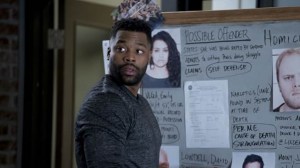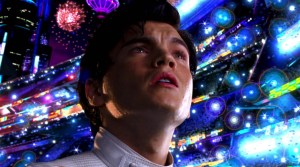Every time I sit down to write about Jack Kirby I’m at a loss for words.
Videos by ComicBook.com
It all sounds so inadequate. It’s hard to encapsulate the man’s life—his career with mere words.
Jack Kirby created worlds.
Everything looked a certain way in Kirby’s world. Hands looked a little different, faces looked a little different, knees, and arms and trees and buildings and water—it was all different from the world we knew. Everything was more exciting in a Kirby world. It was all crackling with energy and dramatically situated. Jack could make the most mundane things look spectacular. A guy pouring himself a glass of milk looked exciting. A passerby reading a newspaper looked great. And fistfights—good lord—nothing was more exciting than a Jack Kirby fistfight!
Jack’s world was consistent in its inconsistencies. Jack eyeballed perspective. If you looked for vanishing points and horizon lines things could be wildly off. His foreshortening was pushed to the limits. Things didn’t make sense. Often figures and buildings and machines worked from one angle only and lord help anybody trying to follow Jack on anything. But it all worked when Jack did it.
The first Kirby comics I ever saw were the Boy Commandos. My dad bought comics when he was a kid and growing up, the Larsen kids were allowed to read and enjoy (and in some cases mutilate beyond recognition) those comics. I liked the Boy Commandos just fine, but they didn’t make a bigger impression than Captain Marvel Adventures or the EC Comics or even Powerhouse Pepper. It’s likely that many of those stories were executed by some of the Kirby imitators who followed Jack’s brief run but I think a story or two were legitimate Kirby material. In any case, my Dad had a ton of comics and with all of the Carl Barks Donald Duck and Uncle Scrooge and the Archie and Mopsie and Nancy and Blue Bolt comics, the few issues of Boy Commandos didn’t stand out especially.
The Last Boy on Earth
When I started buying comics of my own, Jack Kirby was at DC. The New Gods and Forever People had run their course. I think I had an issue of Mister Miracle (#10 if memory serves me) and that was the extent of it.
The book that made a lasting impression on me was Kamandi The Last Boy On Earth.
I wasn’t there from day one. I didn’t see every issue. I bought the ones that I ran across. I can recall having #4 and #5 and seeing ads in the comics for issues 11 and 12 and having them. I had a few scattered other issues as well. Kamandi #32 was a “Giant” issue, which reprinted the first issue in addition to a new story and it featured a Photo gallery, which promised “an intimate glimpse of Jack Kirby!! His life — his home — his studio!!!” It was pretty neat — despite the nearly indecipherable blurry black and white photos printed on newsprint. And the comic itself was pretty incredible stuff. I can remember looking back and forth from the D. Bruce Berry inked lead story to the Mike Royer inked reprint and wondering why the older story looked so much better. It was the first dawning realization that an inker really could make a big difference on what the finished art looked like.
Kamandi worked. Everything about it clicked. I became immersed in this world. In Kirby’s world.
And it was a world very much unlike those of his contemporaries and peers. Jack’s work had become, over the years, increasingly stylized.
Jack had developed a kind of shorthand anatomy early on but as the years ticked by his problem solving became increasingly divorced from the reality of the world around him. The Kirby Crackle that he had used to great effect as energy had taken root and now represented everything from energy to fire, to water, to hair, to the texture on a soldier’s helmet. The squiggles that he had used initially to represent a metallic sheen were on arms and legs and numerous other places. Knees had become bloated and volleyball-sized. Fingers were either squared off (for men) or as sharp as a knife blade (for women). Splash-pages and double-page spreads abounded.
Full-Tilt Kirby
For a guy used to Kirby’s softer imitators or tepid competitors Jack’s art was like a locomotive running at full steam straight at you!
I devoured what issues of Kamandi I could find.
Years later, able to read it all, I’m in awe of just how good this book really was. Yes, the New Gods and Mister Miracle and the Forever People were good books, but Jack’s ideas were spilling out of his head and onto his pages so fast that the ideas lacked focus and cohesion. Ultimately, the Fourth World books failed and I think part of the reason was because they tried to do too much, too quickly. Kirby had worlds to tell you about and he wanted to get it all out there immediately and it simply didn’t gel in a way that readers could easily grasp.
Kamandi gelled.
The world of Kamandi was simple. There was a disaster. Men were reduced to animals and animals had taken over the earth.
There were talking gorillas straight out of Planet of the Apes, sure, but there were Lions and Tigers and Bears (oh my!) along with Wolves and giant Rats and Insects. Kamandi’s goal was to put things right — to find more intelligent, reasoning humans like himself and put mankind back in their rightful place as the leaders of this savage land.

Viewpoint
In the Forever People, Jack made an attempt to sound hip. His characters were flower children, reflecting the world outside his window. But Jack’s hip lingo sounded forced and corny to my young ears. Looking back at it, Jack’s efforts were certainly no more corny than the other writers whose work was deemed hip at the time. Books from the ’70s that tried to be contemporary have not aged well.
Kamandi was a different story.
Kamandi was set in a distant future. Sometime in the past, a natural catastrophe had occurred, exposing the earth to radiation. Kamandi was born and raised in a bunker complex, isolated from the rest of the Earth’s inhabitants, and he gained his knowledge from films that his grandfather showed him. When it was safe, Kamandi came out of his cell and explored this strange new world. But disaster struck! While the boy was away, the complex was broken into and his grandfather was killed. The invaders were wolves and Kamandi’s battle with the two left them dead. With no reason to stay behind, the boy left the bunker complex to venture out on his own. Without it being set in a specific time, Kirby didn’t attempt to make his dialogue contemporary and many of the animals emulated humans from different eras. Tigers rode horses and had a leader named Caesar. Lions were game wardens. Gorillas were heavies. Humans either roamed the Earth, wild, or were slaves or pets — doing tricks for sweets.
The viewpoint of the book was (at least during the time Kirby was writing the book) squarely on its lead character. Supporting characters would come and go. When Kamandi came into contact with Ben Boxer, we’d see what he was up to but when Kamandi was separated from Ben, Ben would cease to exist.
There were no subplots to speak of. The action was intense, the consequences were high and the outcome was often bleak. Characters would die brutally and the world was rife with danger.
Kamandi was Jack’s success story at DC. While the New Gods and Forever People faded away after a measly 11 issues apiece and Omac even less, Jack was on Kamandi for a full 40 issues and it lasted 19 issues beyond that.

I love all of it
Kamandi was my gateway drug for Jack Kirby.
His style became one I could easily recognize. I read what I could while he fulfilled his contract at DC. I took in Omac and The Demon and Atlas, Manhunter and the Dingbats of Danger Street.
When Jack returned to Marvel I was thrilled beyond belief and all of it was consumed with enthusiasm. I snapped up back issues when I could find and afford them and I bought every reprint mag I could get my grubby mitts on. It was all so glorious. The Eternals! 2001! Captain America! Machine Man! Black Panther! Devil Dinosaur! And the Silver Surfer!
It was all so glorious.
But letters pages seemed to think otherwise. Frequently they would run letters panning Jack’s efforts and that made no sense to me. These readers were reading the same comics I was and yet they were walking away having experienced something very different than I had. I’d read the other books on the stands. I was getting damned near everything. Clearly Jack was kicking everybody’s collective ass! Who were these oddballs and why weren’t they getting the same thrill I was getting when I sat down to read a Kirby comic book? Couldn’t they see that everything else was tired and dull in comparison? Other “creators” were recycling Jack’s ideas and reusing Jack’s characters—and there was Kirby, creating a veritable mountain of new characters! Surely they could see the difference as I could.
No matter.
Let the naysayers be damned. I loved all of it.
And I love all of it.

In A Different Future
Decades later I’m writing and drawing comic books of my own and I’m looking back at what Jack did and marveling at its abundance. He’d drawn everything from science fiction to romance, crime stories to war stories, humor to horror, superheroes to dinosaurs. There’s nothing this guy couldn’t do. I’ve tried, really I have, to compete on some level but I find myself thoroughly defeated on every level. Defeated, and yet—inspired. To look through a Kirby comic is to light a creative fire under my ass. Nothing gets me more charged up than looking through his work.
I have dreams of exploring alternate realities and stumbling on another reality where Kirby was handed Wonder Woman instead of Jimmy Olsen. What would he have done with Wonder Woman? What could he have created? What would he have brought to the table? On every assignment I’ve tried to approach it with the thought, “What would Jack do?” And on every book I tried to add as many characters and as many ideas as I could. I have been extremely lucky to have found a home where I can fully explore the boundaries of my own imagination.
It’s frustrating, to some extent, that so many of Jack’s runs were cut short, Kamandi being one of the few where he seemed to have said his piece. So many others were cut short in their prime. I never got to experience Jack’s lengthier runs on Thor and The Fantastic Four as they unfolded. For me, Kamandi was as close as I got and even that was spotty.
There are those who would argue that Kirby’s dialogue was not as smooth and pretty as Stan’s was but I beg to differ with those who don’t think it was as good. Stan’s was more even, perhaps, but while Jack had a few clumsy lines here and there they were more than offset by passages of pure brilliance. Few writers have written words more compelling than Kirby. The emotion! The drama! The genuine affection characters had for one another. Kirby could do things with words like nobody else. Kamandi #1 comes as close to being a perfect first issue as anything before or since and I challenge anybody to read Kamandi #6 and not push back from the table with a tear in their eye! When the Swine confronted prisoners in Captain America you feel anger toward him like no other comic book super villain.
Words fail me.
Ultimately, Jack left Marvel to pursue a career in animation and we were all worse off for it. Jack found the support and comfort he needed and good for him. He had worked hard to provide for his family and when comics failed him he didn’t fail them. Jack found a way.
When Image started up we did a book with Jack. We all took turn inking pages of a story cobbled together with unused inventory pages. It was a patchwork job in many respects and a labor of love for each and every one of us. All of the creators volunteered their time and efforts for Jack and when the royalty check for Phantom Force #1 came in it was the largest check Jack had seen in his lifetime. I was proud to have given back to the man who had given me, and all of us, so very much.
Jack’s gone now but his work and his memory remains.
They called him the King and I have no doubt that no creator will ever assume his crown.









